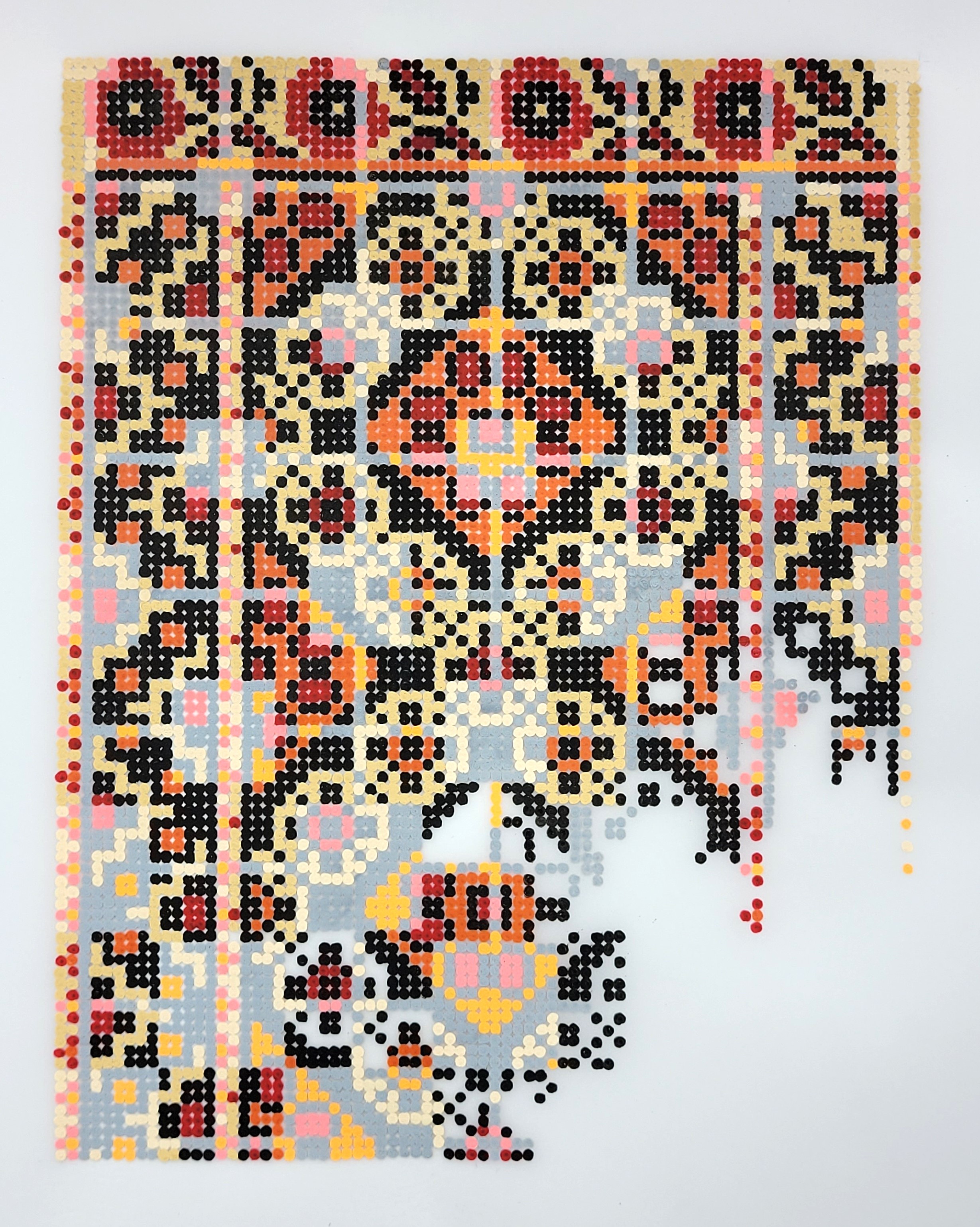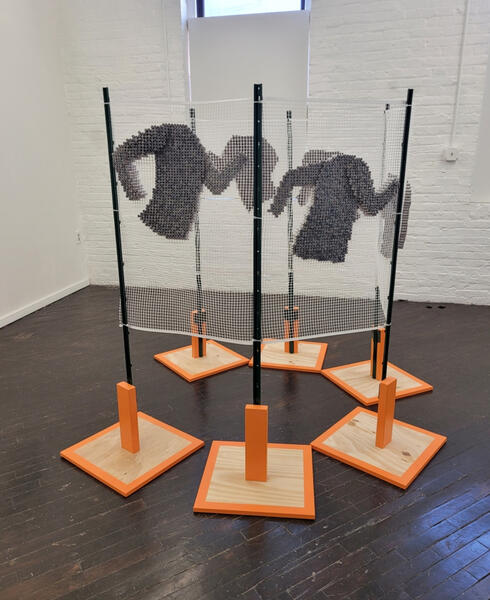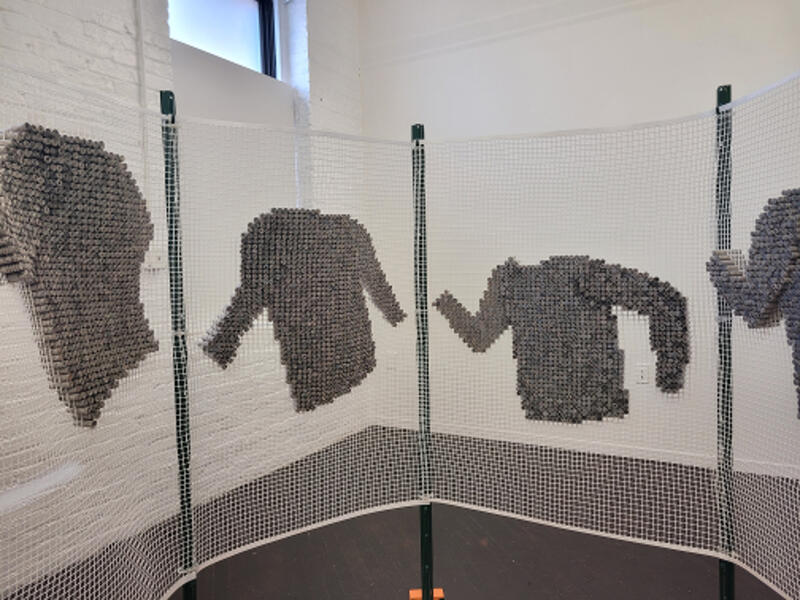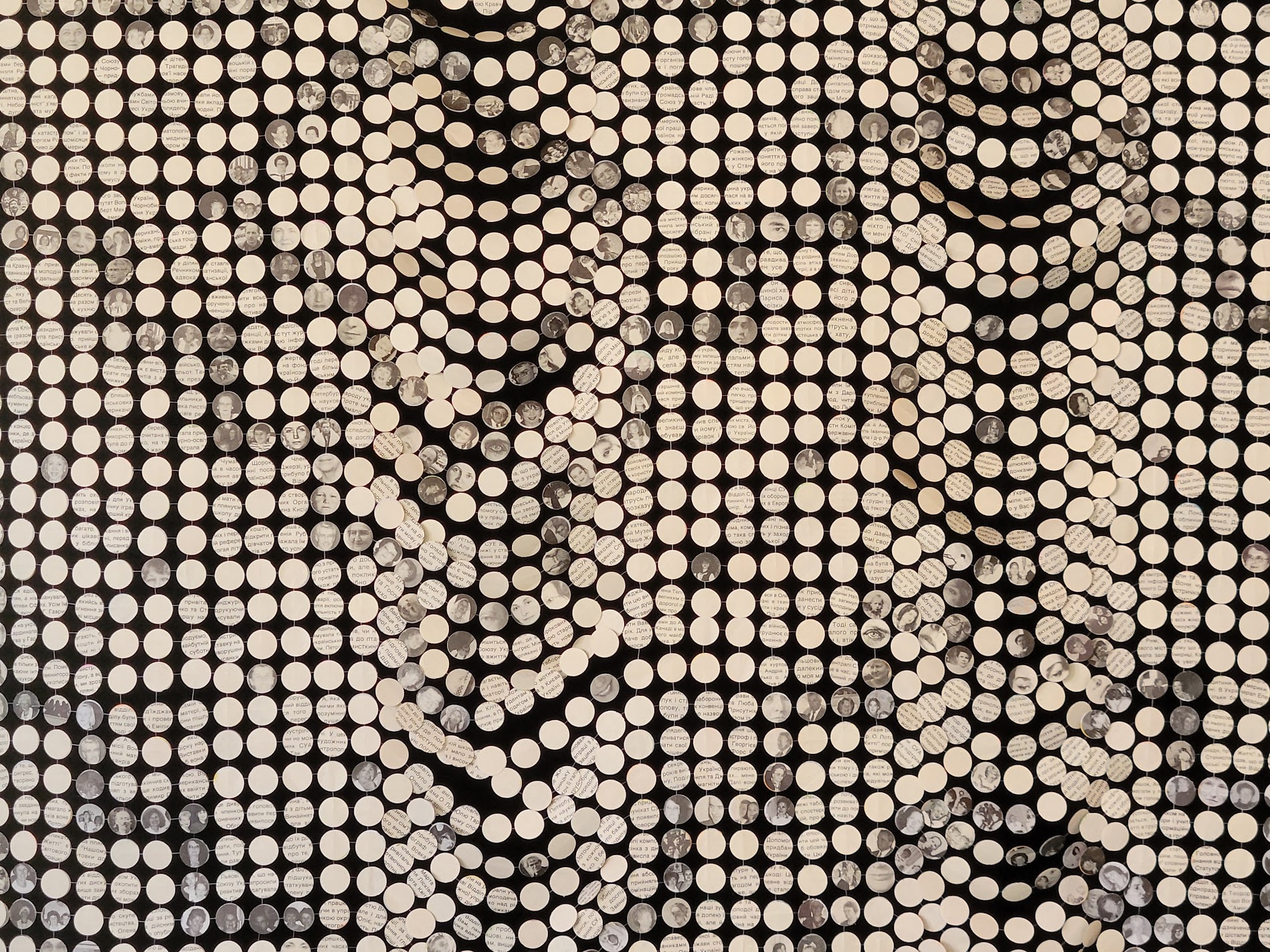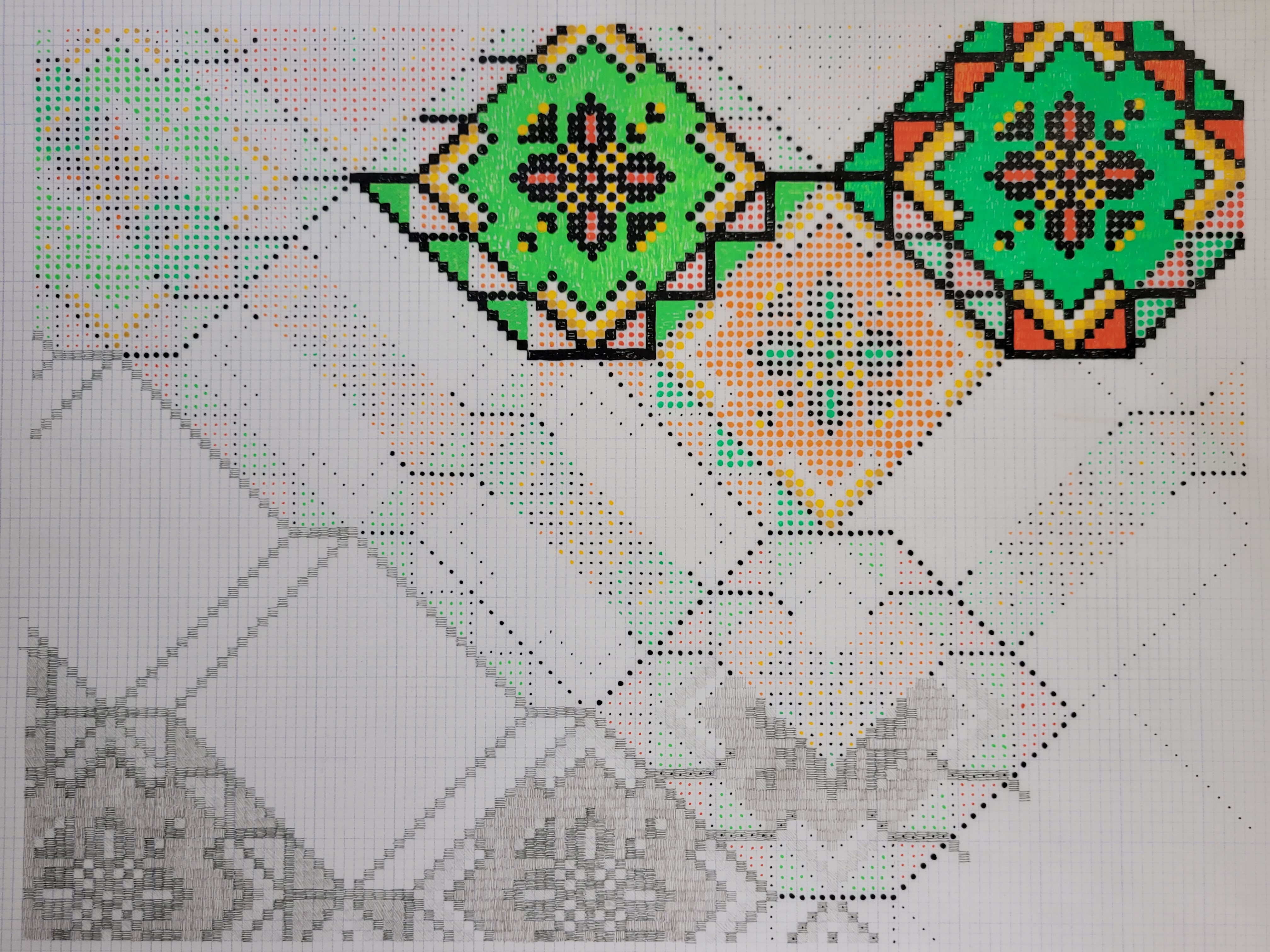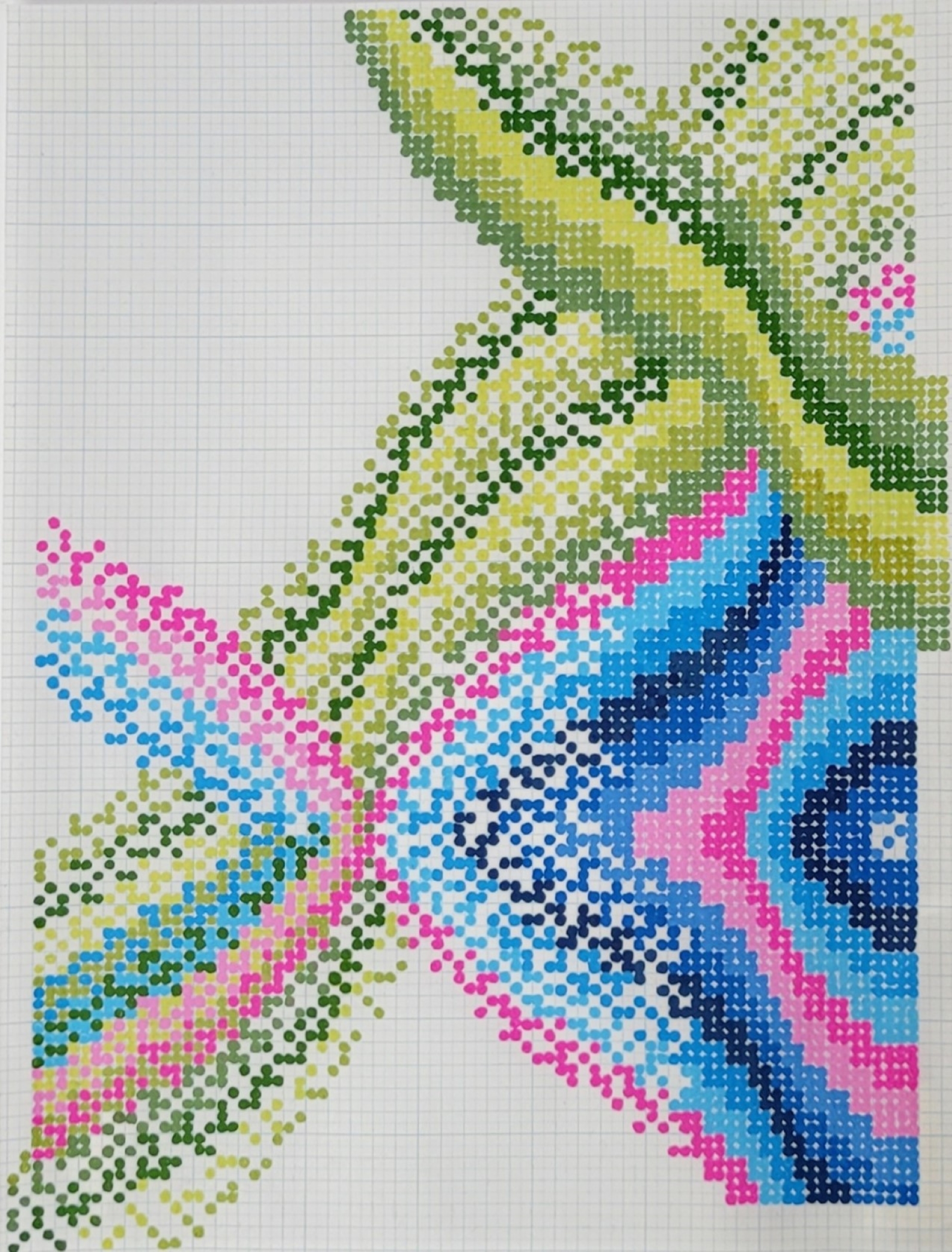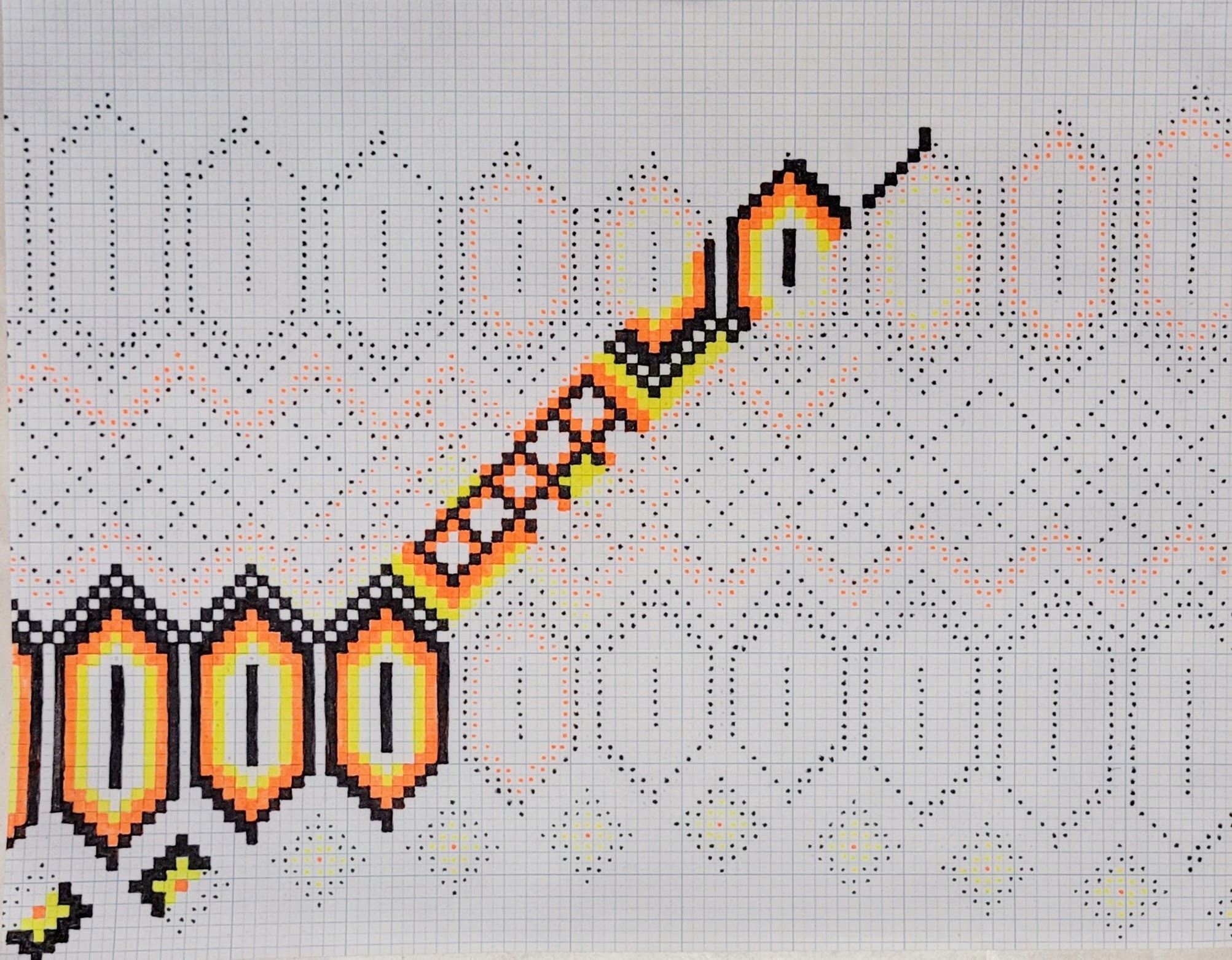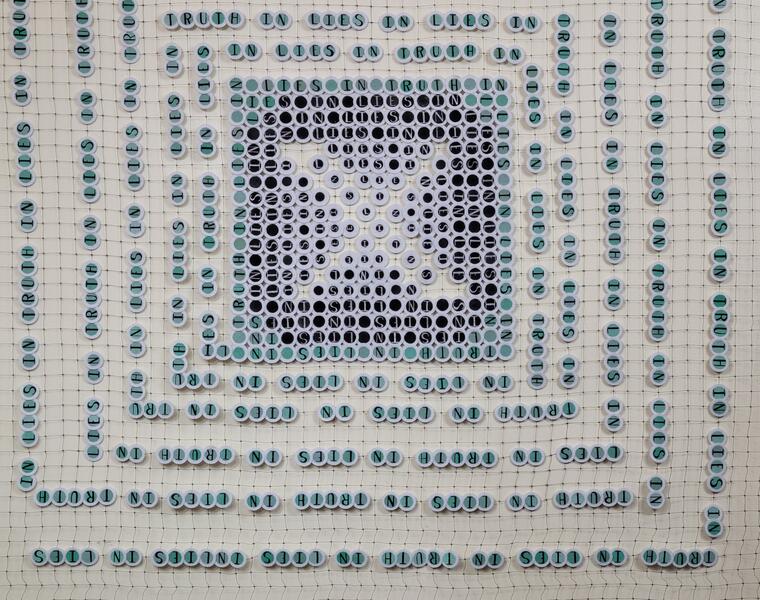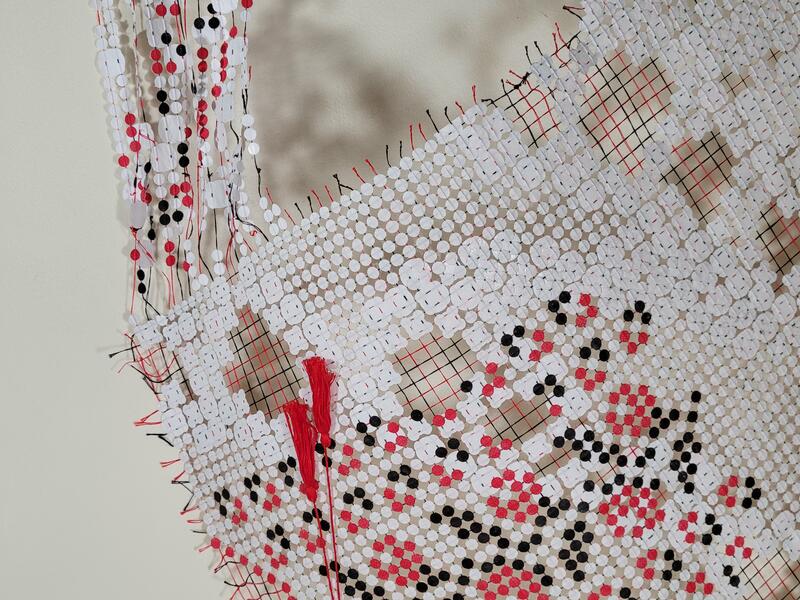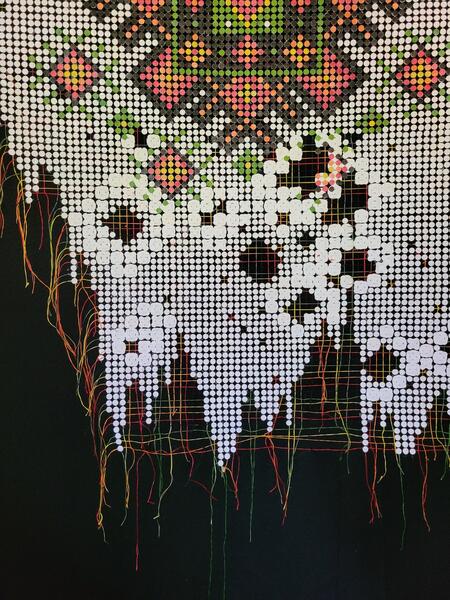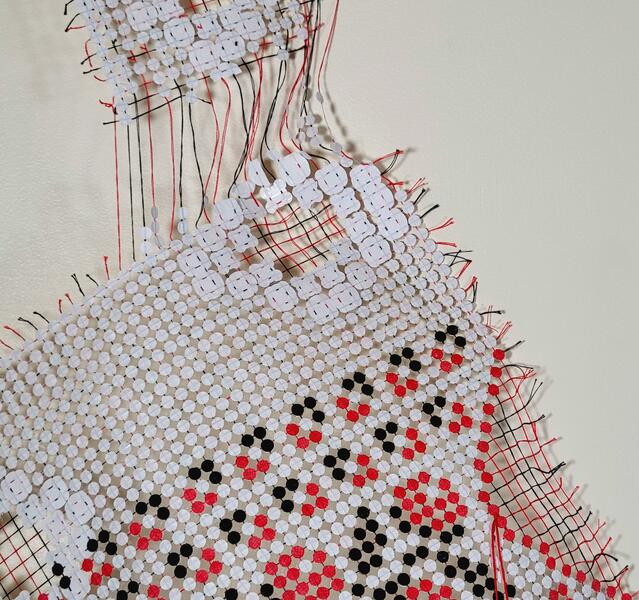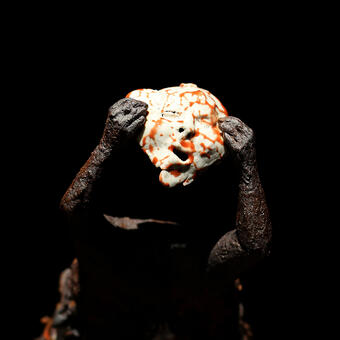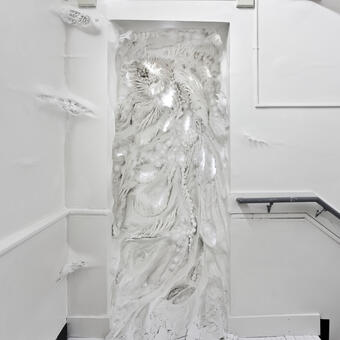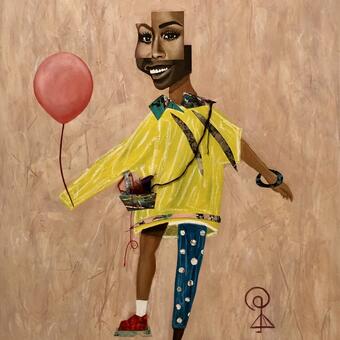Work samples
-
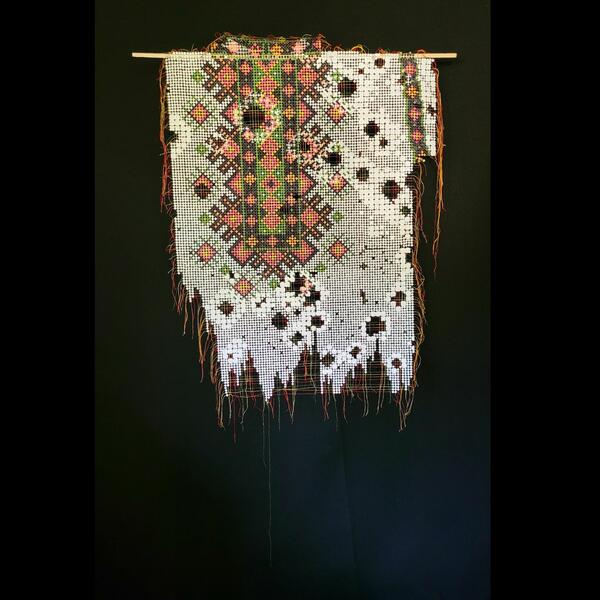 holding pattern
holding patterncircles cut from security envelopes and 2022 Наше Життя (Our Life) magazines, embroidery thread, and acrylic paint
36” x 54” 2023
For this piece about the most recent invasion of Ukraine, I first created a traditional Hutsul pattern inspired by shirts worn by me and my family. I then enlarged the вишиванка (vyshyvanka) to beyond human scale. This region’s patterns are specifically geometric and colorful. The colors and the embroidery of all Ukrainian shirts hold significance and are said to be a talisman against evil. To make this work I punched ¼” – ½” circles from Ukrainian magazines (circa 2022-2023) and from my stash of saved security envelopes. I adhered the circles to embroidery thread that I wove into an open grid.
-
impact
acrylic on mylar
2025
14" x 20"
This piece is based on a traditional Hutsul embroidery pattern that is being pulled apart yet still retains enough of its origin story. The making of this inspired me to create the ongoing All the ways you tried series of works on vellum, Yupo, and larger paper tapestries.
Available for PurchasePrice on request - please contact the artist.
-
a systematic takeover (side view)
(from the series All the ways you tried)
circles cut from security envelopes, embroidery thread, acrylic paint 2025
32" x 24"
The paper tapestry, a systematic takeover, was made by punch cutting individual circles from painted security envelopes and adhering them to embroidery thread that was woven into an open grid. The square pattern that is marching across the tapestry is removing parts of the traditional embroidery pattern (a hybrid from a few regions of Ukraine). Ukrainian embroidery is considered to be a talisman against evil. Wearing an embroidered shirt is meant to protect you, but this is a psychological protection – as the security envelope is meant to protect what it contains even though it can be easily opened. Believing in these protections, to me, goes beyond paganism, superstitions, or – in the case of the envelope – trust. I also see optimism. Despite the erosion, we can still gather enough information to rebuild.
Available for PurchasePrice on request - please contact the artist.
-
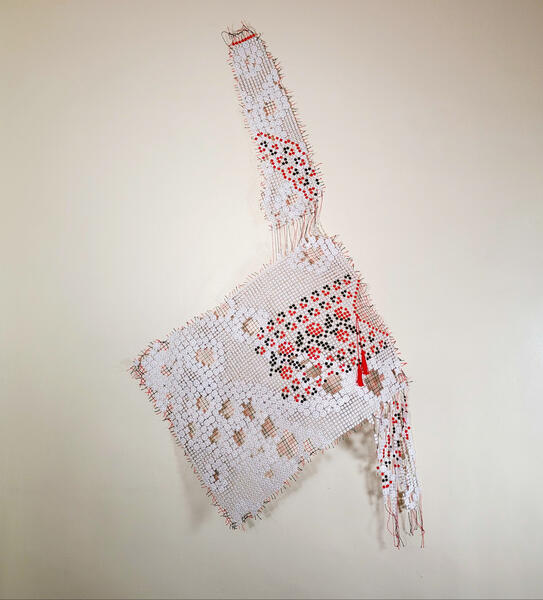 holding pattern (holding on)
holding pattern (holding on)circles cut from security envelopes and Наше Життя (Our Life) magazines, embroidery thread, and acrylic paint
dimensions variable (shown here as 43” x 28” x 4”) 2023
This pattern is based on a floral design from one of the Ukrainian embroidered blouses (vyshyvanka - вишиванка) my sister and I wore as children while performing traditional dances. To make this work I punched ¼” – ½” circles from Ukrainian magazines and security envelopes I have saved over the years. I adhered the circles to embroidery thread that I wove into an open grid.
About Julianna
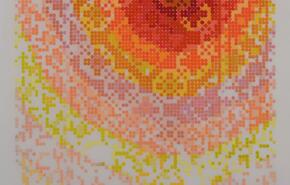
Starting with an investigation of patterns, like those found in storytelling, (mis)communication, textiles, and behaviors; my work speaks about comfort versus security, identity, gender norms, or accountability of actions.
I have methodically cut text to create work about banned books, woven multiples of miniature pants to speak about war, and created a crime scene between the characters of Dorothy and Alice to question our archetypes of gender. My dominant materials are typically from… more
All the ways you tried...
This series of works on translucent Yupo and vellum were made using the same embroidery design over and over again as a stand in for an individual, a culture, a country... all the ways we are tried and still stay visible.
-
 a systematic takeover
a systematic takeoveracrylic on vellum
2025
14" x 11.5"
-
dismantling
acrylic on vellum
2025
14" x 11.5"
-
intrusion
acrylic on vellum
2025
14" x 11.5"
-
indoctrination
acrylic on Yupo
2025
14" x 11.5"
-
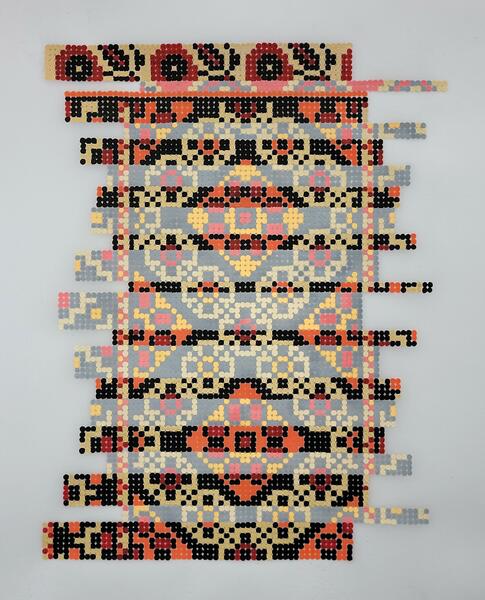 coercion
coercionacrylic on Yupo
2025
14" x 11.5"
-
invasion
acrylic on vellum
2025
14" x 11.5"
-
cover ups
acrylic on vellum
2025
14" x 11.5"
-
infiltration
acrylic on Yupo
2025
14" x 11.5"
-
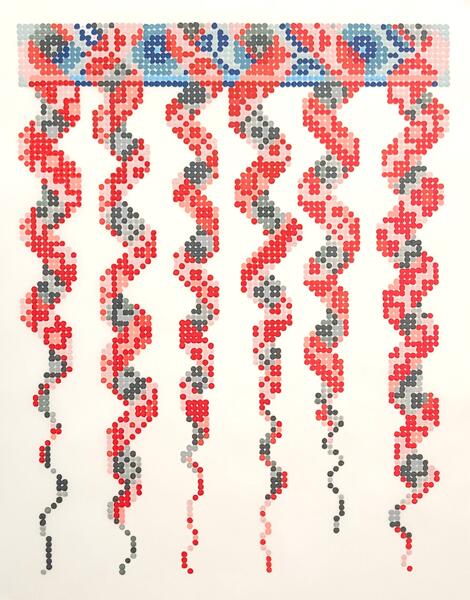 presenting lies as truth
presenting lies as truthacrylic on vellum
2025
14" x 11.5"
Breaking News
For this piece I cut newspapers into strips of 3 different heights and rolled each to fit into the fencing. Starting with one torso made entirely of newspaper, I then gradually added gray felt to the rest of the torsos.
I chose felt as it is made from matting and condensing separate fibers into one – similar to how news is, at times, shared. Hopefully, in the process, we don’t end up too far from the truth.
the rest of the story
the rest of the story, 2023
circles cut from 1991-92 Наше Життя (Our Life) magazines and the artist’s drawings from 2022-23, ink, marker, acrylic paint, pencil, gridded fade-out vellum, and monofilament - Dimensions are variable
For the rest of the story, I pulled Ukrainian magazines from my mother’s collection that spans decades. I purposefully chose copies from August 1991 through 1992 – spanning the first year of Ukraine’s Independence. I cut over 3000 1/2" circles of faces, hands, and text from these magazines and then backed them with over 3000 more cut circles from my 2022 and 2023 sketches and drawings. The circles are attached to hand woven monofilament. The Ukrainian pattern that emerges is ongoing.
-
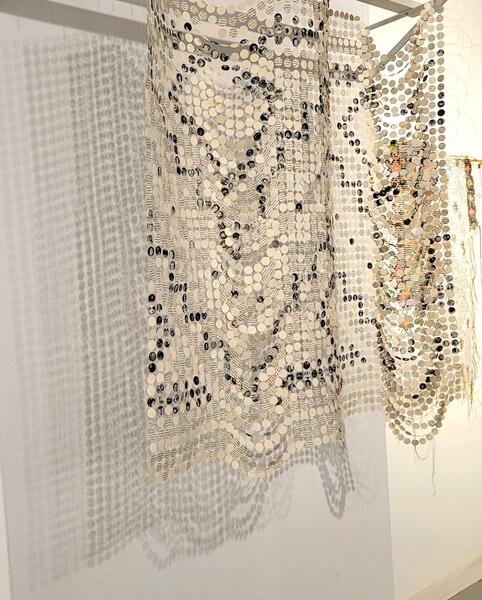 the rest of the story (detail of the magazine side as exhibited at Artscape's B23 exhibition)
the rest of the story (detail of the magazine side as exhibited at Artscape's B23 exhibition) -
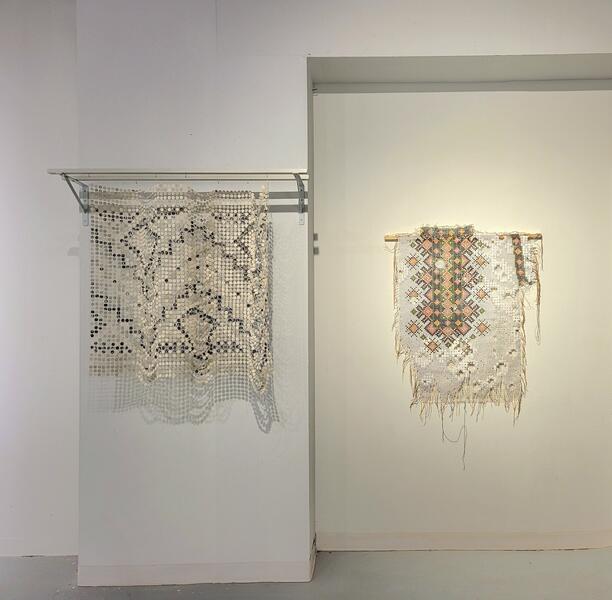 the rest of the story (exhibition view)
the rest of the story (exhibition view)This image shows the rest of the story at Artscape's B23 exhibition alongside another paper tapestry of mine, holding on.
-
 the rest of the story (detail of magazine side)
the rest of the story (detail of magazine side) -
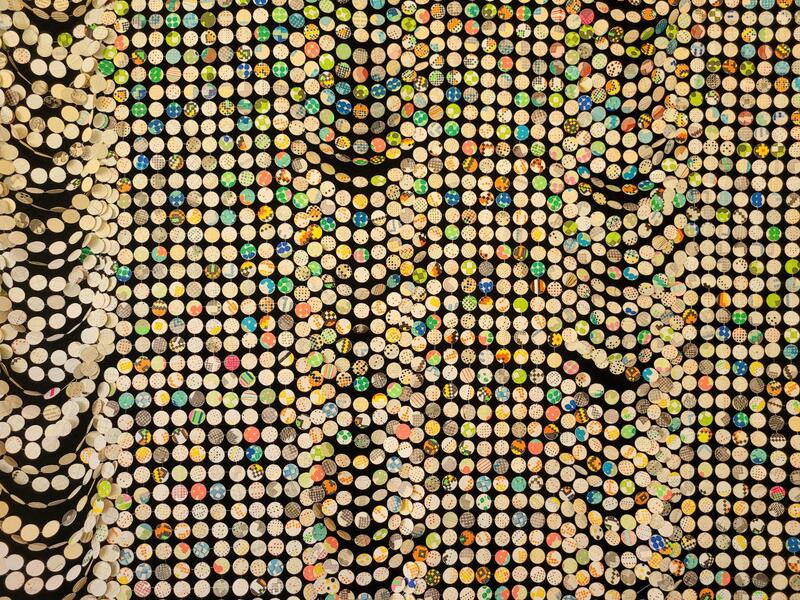 the rest of the story (detail of studio drawings side)
the rest of the story (detail of studio drawings side) -
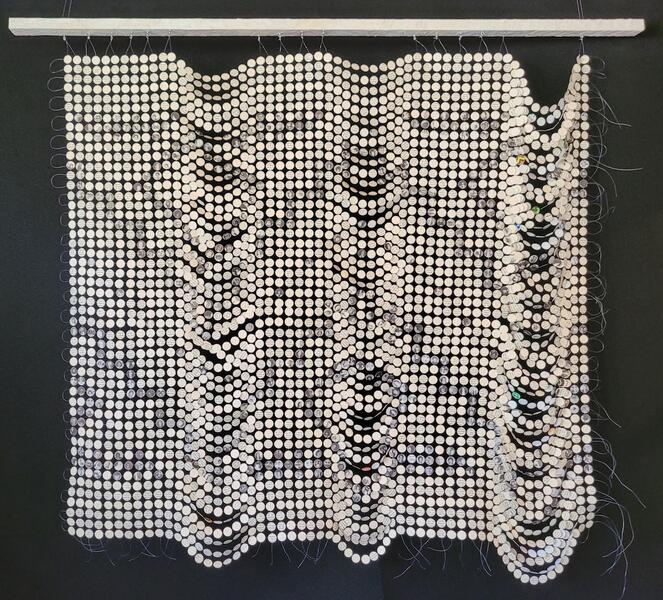 the rest of the story
the rest of the story
works on paper
All of these works on paper are based on historical textile patterns. The patterns have been altered to include an ebb and flow, push and pull, or tattered to mended to correlate the movements and moods in our daily lives and in our larger shared history. The origin of moments of impact can adjust our lives for a brief time or for the rest of time. How can we tell when we have gone back to the original patterns of our life? Do we ever actually go back? How much do we continue to pass on to others? I work on gridded paper which allows a direct reference to the way embroidery patterns are recorded and passed down in many cultures. I am also drawn to the historical context of the grid in art. This series started in 2021 with status.
-
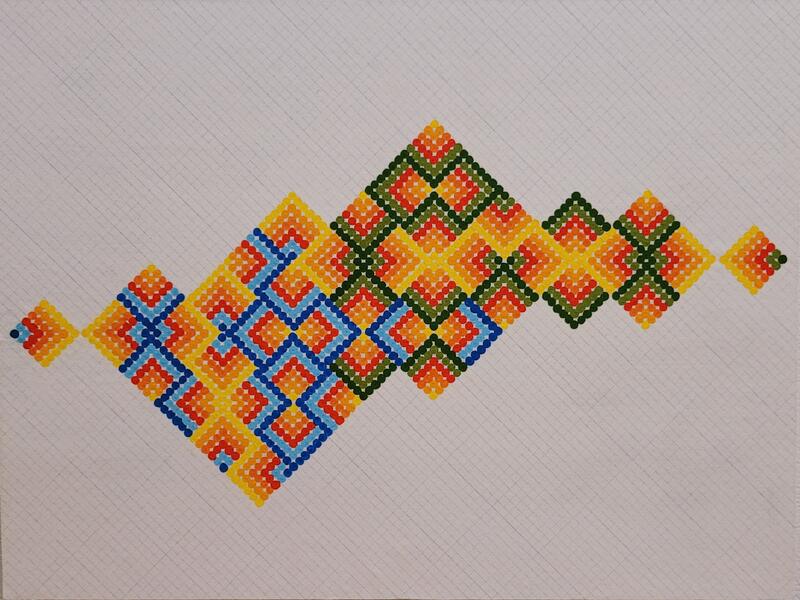 switching sides
switching sidesswitching sides 2024
acrylic on fade out gridded vellum
9" x 12"
-
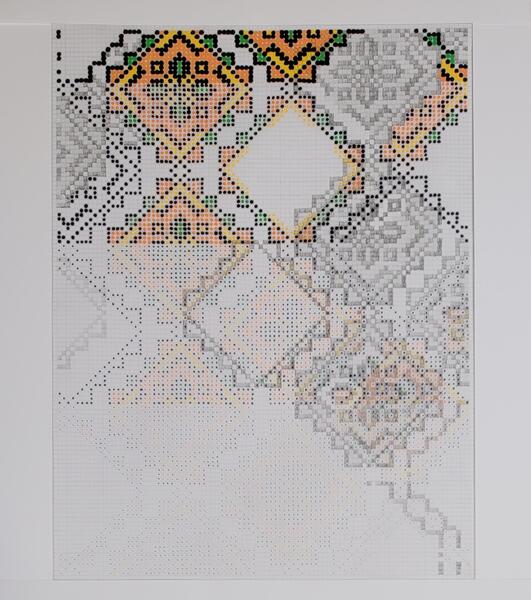 offset - 2023 - acrylic and ink on fade out gridded vellum 15.25” x 11.5”
offset - 2023 - acrylic and ink on fade out gridded vellum 15.25” x 11.5”This piece is based on a traditional Hutsul pattern from my family’s culture but laid out in repetitions that would never be seen historically. The Hutsuls are an indigenous population of the Carpathian Mountains and, over generations, those in Western Ukraine have come to be known as Ukrainian. Many have an entwined Hutsul and Ukrainian culture; my family included. Like a multitude of countries and ethnicities in the world, Ukrainians are again in an upheaval, and questions abound about how much outreach other countries should extend to those in need. What is a person’s or country’s obligation upon witnessing turmoil?
-
 bystander - 2023 - acrylic and ink on fade out vellum - 15.25" x 11.5"
bystander - 2023 - acrylic and ink on fade out vellum - 15.25" x 11.5"This piece is based on a traditional Hutsul pattern from my family’s culture but laid out in a repetition that would never be seen historically. The Hutsuls are an indigenous population of the Carpathian Mountains and, over generations, those in Western Ukraine have come to be known as Ukrainian. Many have an entwined Hutsul and Ukrainian culture; my family included. Like a multitude of countries and ethnicities in the world, Ukrainians are again in an upheaval, and questions abound about how much outreach other countries should extend to those in need. What is a person’s or country’s obligation upon witnessing turmoil?
-
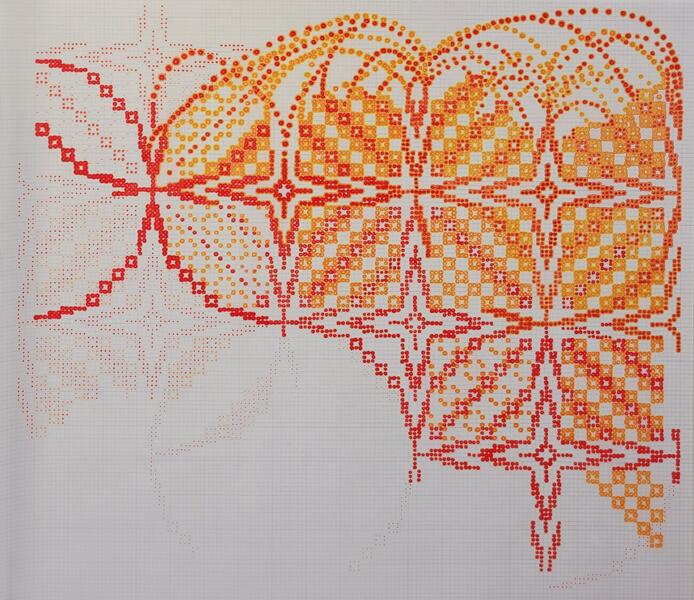 17_JuliannaDail.jpg
17_JuliannaDail.jpgacrylic and ink on fade out gridded vellum
18” x 20” 2022 This piece is based on an early American coverlet pattern for a four-harness loom. The original pattern was adapted for the 'Gobelin stitch', a form of Bargello stitch. Many stitch patterns have an unclear provenance despite being labeled as, or considered influenced by, Bargello.
-
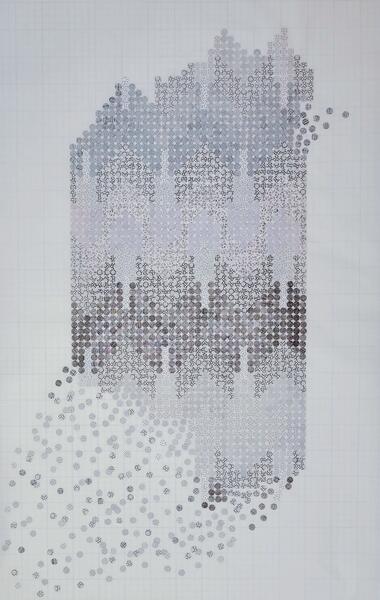 unattended - 2023 - cut from salvaged security envelopes, graphite, fade out gridded vellum - 24” x 15”
unattended - 2023 - cut from salvaged security envelopes, graphite, fade out gridded vellum - 24” x 15”If left alone some things become more inherently beautiful and spread out naturally while other times leaving things alone causes unraveling. For this piece I researched a Florentine stitch work because of the issues of provenance with patterns considered to be Bargello. I saved multiple styles of security envelopes and used them to punch out 1/4" circles. I then individually glued the circles into the altered historic flame stitch pattern and darkened in some of the security patterns with graphite.
-
 11_JuliannaDail.jpg
11_JuliannaDail.jpgdislodging
acrylic, ink, and graphite on fade out gridded vellum
12” x 17” 2022
This piece is from a body of work based on investigating historical textile patterns. The patterns have been altered to include an ebb and flow, push and pull, or tattered to mended to correlate the movements and moods in our daily lives and in our larger shared history. For dislodging I chose to work on gridded paper which allows a direct reference to the way embroidery patterns are recorded and passed down in many cultures. There is a connection among people from different times and places when the patterns of daily life are graphed and a connection to many artists who also choose to use the grid. This piece is based off a traditional Hutsul pattern from my family’s culture. The Hutsuls are an indigenous population of the Carpathian Mountains and, over generations, those in Western Ukraine have come to be known as Ukrainian. Many have an entwined Hutsul and Ukrainian culture; my family included. Like a multitude of countries and ethnicities in the world, Ukrainians are again in an upheaval, but our traditions and language remain tethered.
-
 predictive coding - 2022 - acrylic on gridded vellum - 11” x 8.5”
predictive coding - 2022 - acrylic on gridded vellum - 11” x 8.5”A drawing based on historic Florentine fiber work (aka Flame & Hungarian stitch) and the title, Predictive Coding, is the term for how our brains constantly create mental models of our surroundings based off of previous recollections and content - this helps us predict our sensory input more efficiently. For example, your hand touches something cold, and you know you had a drink nearby, so your brain assumes it's the drink before you look to see that it is indeed the drink or something else (maybe the cold nose of your dog or your kid's fingers). We assume horses not zebras... What happens when our previous recollections and content are from unhealthy situations?
-
 you miss what you don't see
you miss what you don't seeink on gridded vellum
8.5" x 11" 2021
-
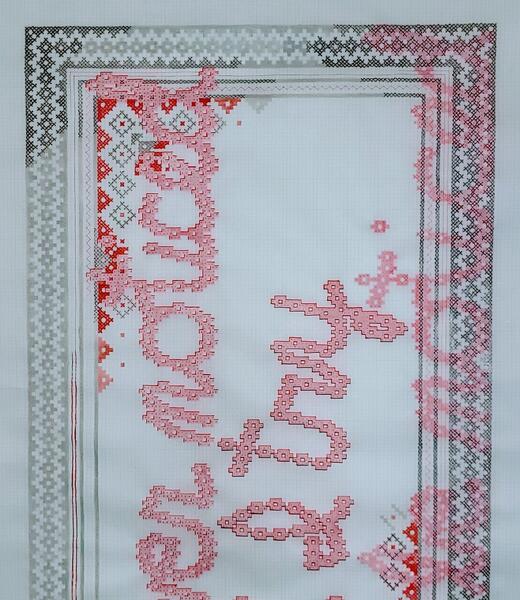 status (detail)
status (detail) -
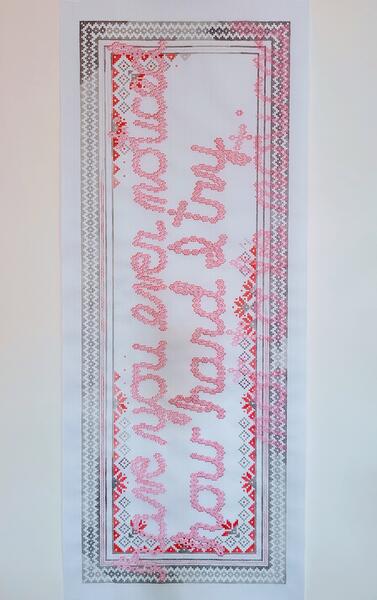 status - 2021 - acrylic and ink on fade out gridded vellum - 47" x 18"
status - 2021 - acrylic and ink on fade out gridded vellum - 47" x 18"The treatment of oneself is based on how others view us and social/societal perception. How we are taught to present ourselves – How we perceive others see us – How we may suppress parts of our identity based on past experiences and future perceptions… This piece speaks about my childhood perception of my immigrant mother and how she moved through public spaces.
I began by working on an embroidery piece using the cultural designs that were passed down to me. I realized that it was the pattern of the embroidery that was the right end for this piece – the pattern/plan allows many to make their own and also their own version. I referenced the scale of a рушник (a rushnyk is an embroidered towel). When it is narrow and long it is still called a ‘towel’ but is meant to be kept clean and is used as a ritual cloth in ceremonial events such as weddings, traditional dances, funerals, or to drape across the frame of an icon hanging in the home.
detail images
The following are detail images of my work.
